MIS500: Walmart - Data Analytics and Business Intelligence Plan
VerifiedAdded on 2022/08/28
|15
|3919
|40
Report
AI Summary
This report provides a comprehensive analysis of data analytics and business intelligence strategies for Walmart, addressing the challenges and opportunities in leveraging big data to improve business operations. It begins by outlining the Ackoff hierarchy of data and then delves into Walmart's value chain, highlighting the importance of data-centric decision-making. The report discusses various business intelligence tools utilized by Walmart, such as Mupd8, Hadoop, and NoSQL, and their applications in optimizing customer experiences and supply chain management. It justifies the proposed solutions, emphasizing the expected gains in efficiency, customer satisfaction, and profitability. Furthermore, the report includes recommendations for improving Walmart's operations through technologies like Radio Frequency Identification and suggests strategies for better customer handling and internal process optimization. The report concludes by underscoring the significance of data analytics and business intelligence in maintaining Walmart's competitive edge and fostering its continued growth, all while acknowledging that Desklib provides students with access to similar past papers and solved assignments.
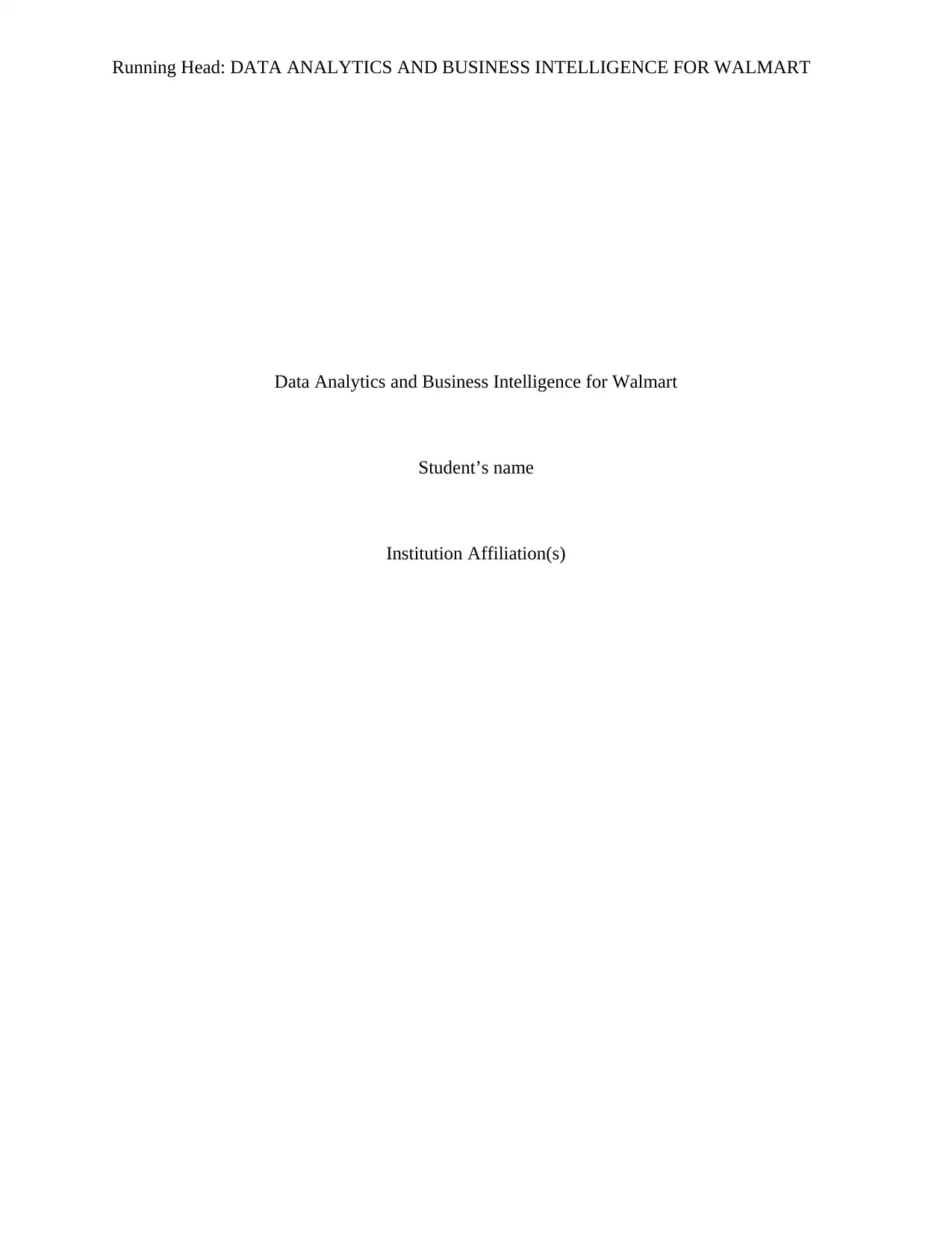
Running Head: DATA ANALYTICS AND BUSINESS INTELLIGENCE FOR WALMART
Data Analytics and Business Intelligence for Walmart
Student’s name
Institution Affiliation(s)
Data Analytics and Business Intelligence for Walmart
Student’s name
Institution Affiliation(s)
Paraphrase This Document
Need a fresh take? Get an instant paraphrase of this document with our AI Paraphraser
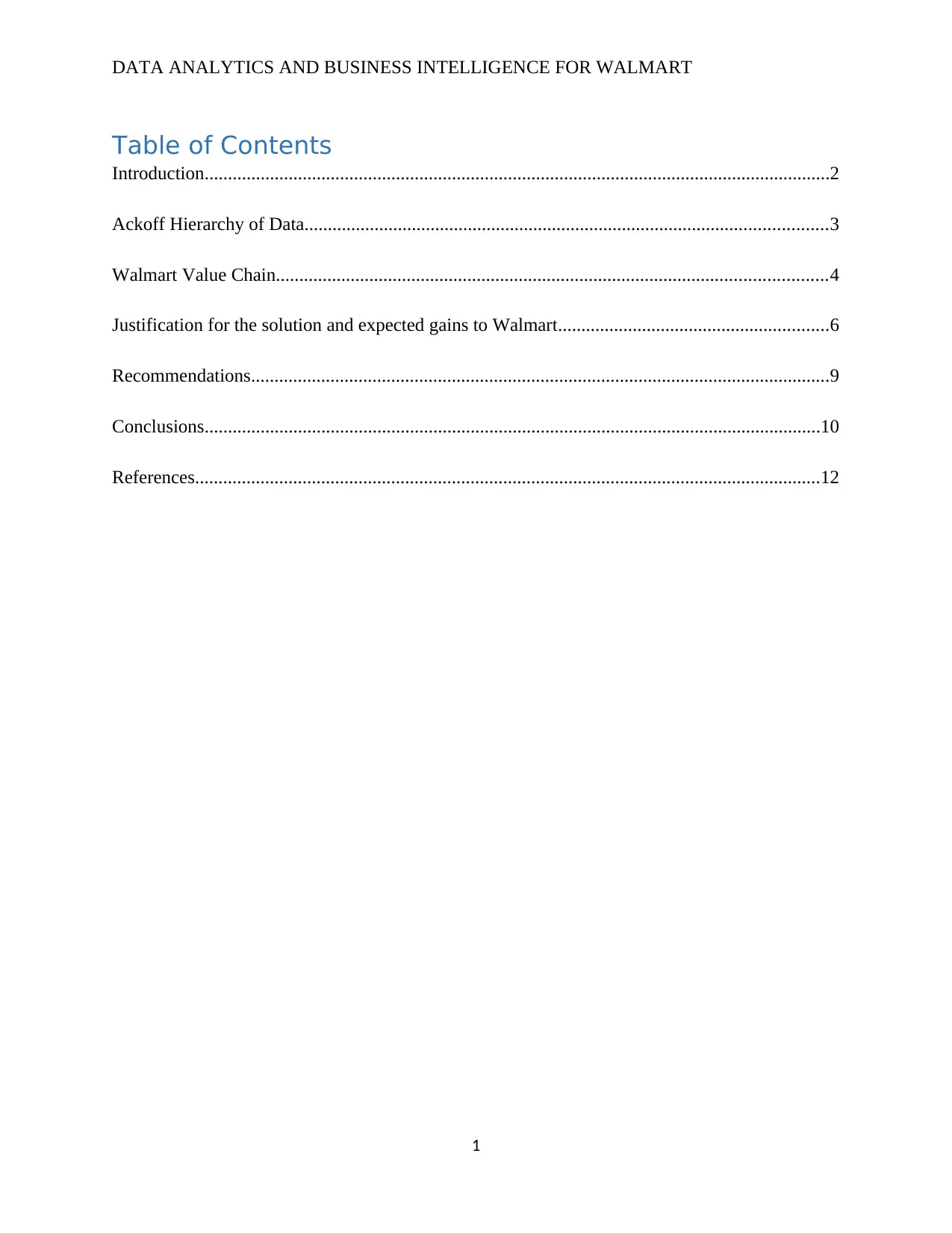
DATA ANALYTICS AND BUSINESS INTELLIGENCE FOR WALMART
Table of Contents
Introduction......................................................................................................................................2
Ackoff Hierarchy of Data................................................................................................................3
Walmart Value Chain......................................................................................................................4
Justification for the solution and expected gains to Walmart..........................................................6
Recommendations............................................................................................................................9
Conclusions....................................................................................................................................10
References......................................................................................................................................12
1
Table of Contents
Introduction......................................................................................................................................2
Ackoff Hierarchy of Data................................................................................................................3
Walmart Value Chain......................................................................................................................4
Justification for the solution and expected gains to Walmart..........................................................6
Recommendations............................................................................................................................9
Conclusions....................................................................................................................................10
References......................................................................................................................................12
1
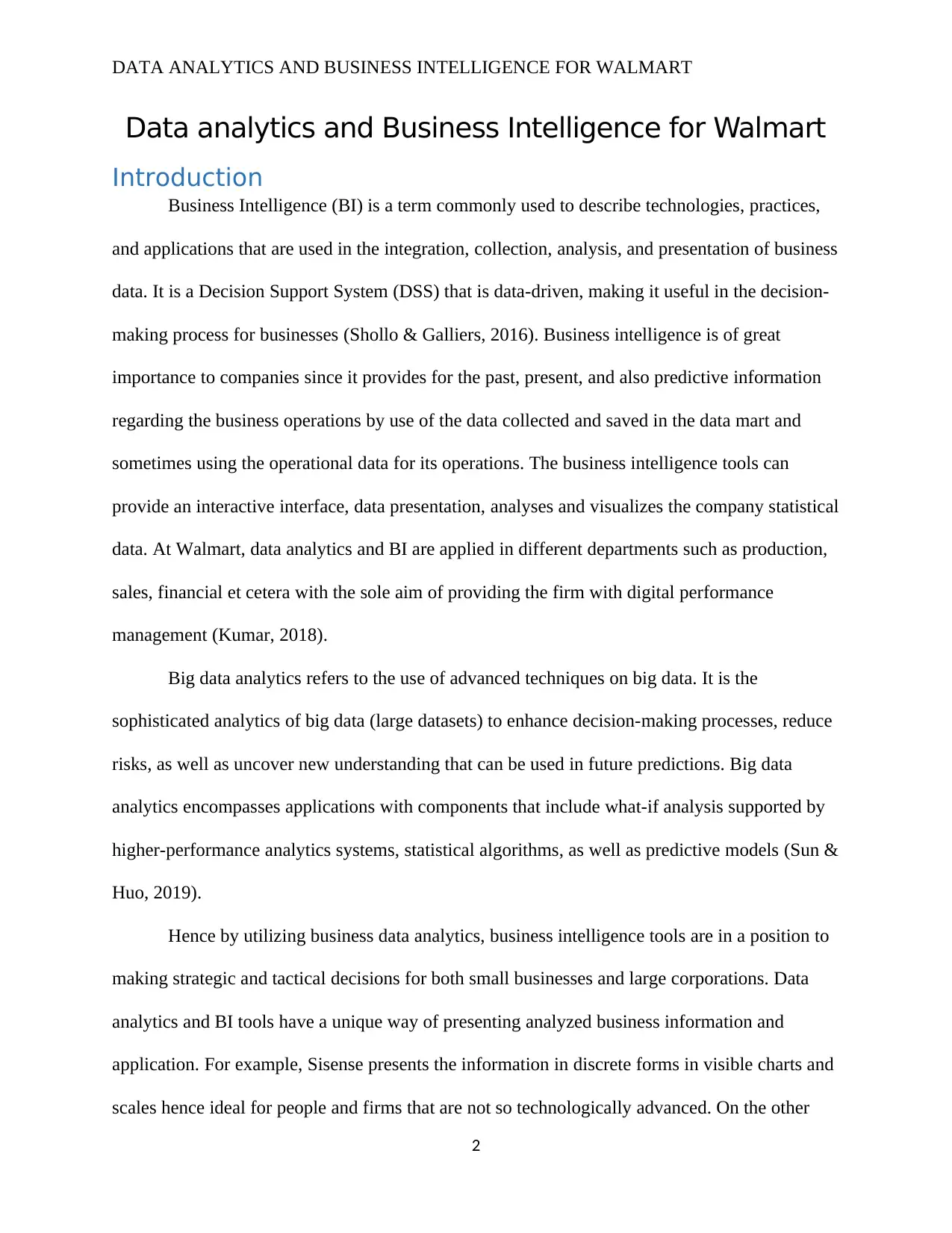
DATA ANALYTICS AND BUSINESS INTELLIGENCE FOR WALMART
Data analytics and Business Intelligence for Walmart
Introduction
Business Intelligence (BI) is a term commonly used to describe technologies, practices,
and applications that are used in the integration, collection, analysis, and presentation of business
data. It is a Decision Support System (DSS) that is data-driven, making it useful in the decision-
making process for businesses (Shollo & Galliers, 2016). Business intelligence is of great
importance to companies since it provides for the past, present, and also predictive information
regarding the business operations by use of the data collected and saved in the data mart and
sometimes using the operational data for its operations. The business intelligence tools can
provide an interactive interface, data presentation, analyses and visualizes the company statistical
data. At Walmart, data analytics and BI are applied in different departments such as production,
sales, financial et cetera with the sole aim of providing the firm with digital performance
management (Kumar, 2018).
Big data analytics refers to the use of advanced techniques on big data. It is the
sophisticated analytics of big data (large datasets) to enhance decision-making processes, reduce
risks, as well as uncover new understanding that can be used in future predictions. Big data
analytics encompasses applications with components that include what-if analysis supported by
higher-performance analytics systems, statistical algorithms, as well as predictive models (Sun &
Huo, 2019).
Hence by utilizing business data analytics, business intelligence tools are in a position to
making strategic and tactical decisions for both small businesses and large corporations. Data
analytics and BI tools have a unique way of presenting analyzed business information and
application. For example, Sisense presents the information in discrete forms in visible charts and
scales hence ideal for people and firms that are not so technologically advanced. On the other
2
Data analytics and Business Intelligence for Walmart
Introduction
Business Intelligence (BI) is a term commonly used to describe technologies, practices,
and applications that are used in the integration, collection, analysis, and presentation of business
data. It is a Decision Support System (DSS) that is data-driven, making it useful in the decision-
making process for businesses (Shollo & Galliers, 2016). Business intelligence is of great
importance to companies since it provides for the past, present, and also predictive information
regarding the business operations by use of the data collected and saved in the data mart and
sometimes using the operational data for its operations. The business intelligence tools can
provide an interactive interface, data presentation, analyses and visualizes the company statistical
data. At Walmart, data analytics and BI are applied in different departments such as production,
sales, financial et cetera with the sole aim of providing the firm with digital performance
management (Kumar, 2018).
Big data analytics refers to the use of advanced techniques on big data. It is the
sophisticated analytics of big data (large datasets) to enhance decision-making processes, reduce
risks, as well as uncover new understanding that can be used in future predictions. Big data
analytics encompasses applications with components that include what-if analysis supported by
higher-performance analytics systems, statistical algorithms, as well as predictive models (Sun &
Huo, 2019).
Hence by utilizing business data analytics, business intelligence tools are in a position to
making strategic and tactical decisions for both small businesses and large corporations. Data
analytics and BI tools have a unique way of presenting analyzed business information and
application. For example, Sisense presents the information in discrete forms in visible charts and
scales hence ideal for people and firms that are not so technologically advanced. On the other
2
⊘ This is a preview!⊘
Do you want full access?
Subscribe today to unlock all pages.

Trusted by 1+ million students worldwide
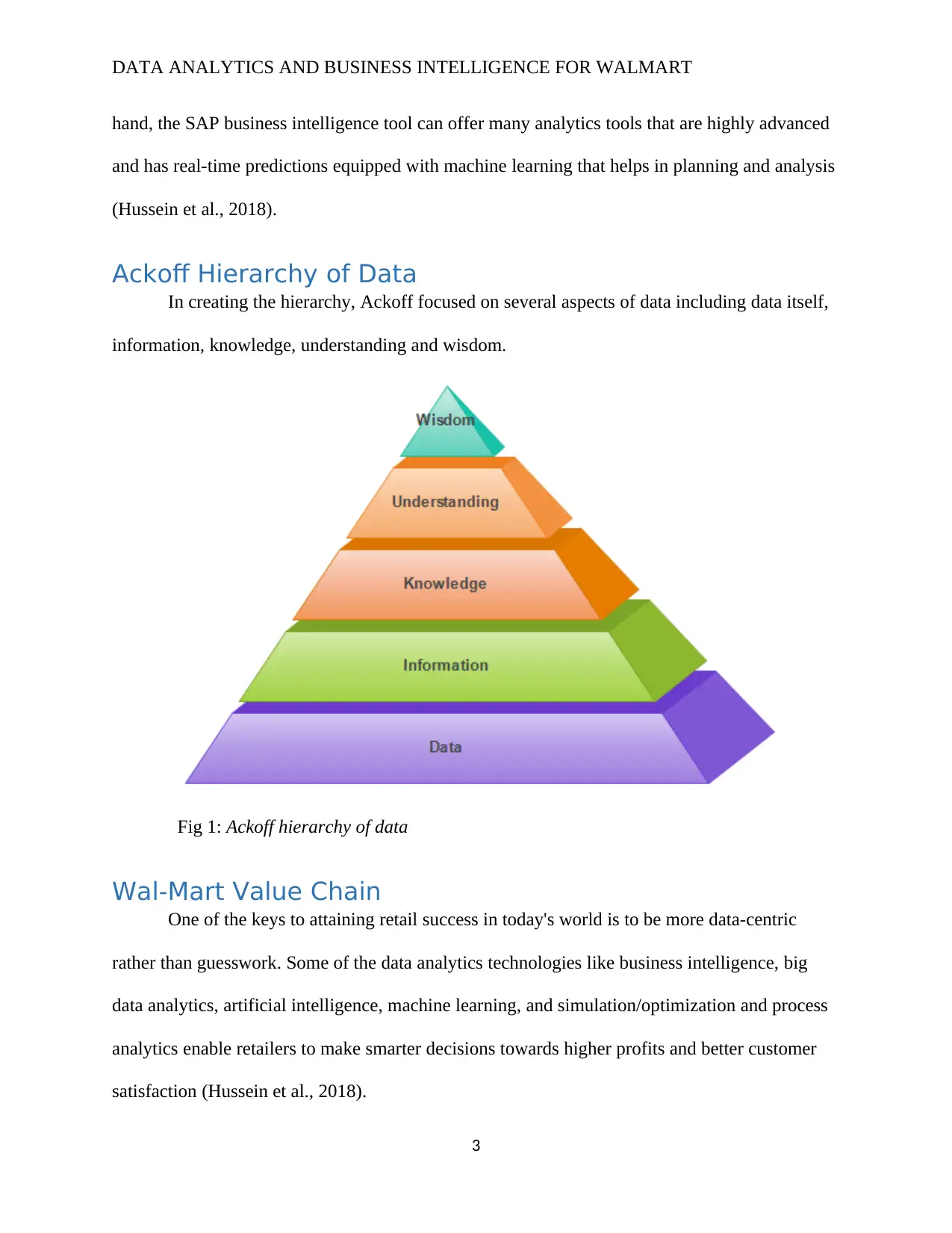
DATA ANALYTICS AND BUSINESS INTELLIGENCE FOR WALMART
hand, the SAP business intelligence tool can offer many analytics tools that are highly advanced
and has real-time predictions equipped with machine learning that helps in planning and analysis
(Hussein et al., 2018).
Ackoff Hierarchy of Data
In creating the hierarchy, Ackoff focused on several aspects of data including data itself,
information, knowledge, understanding and wisdom.
Fig 1: Ackoff hierarchy of data
Wal-Mart Value Chain
One of the keys to attaining retail success in today's world is to be more data-centric
rather than guesswork. Some of the data analytics technologies like business intelligence, big
data analytics, artificial intelligence, machine learning, and simulation/optimization and process
analytics enable retailers to make smarter decisions towards higher profits and better customer
satisfaction (Hussein et al., 2018).
3
hand, the SAP business intelligence tool can offer many analytics tools that are highly advanced
and has real-time predictions equipped with machine learning that helps in planning and analysis
(Hussein et al., 2018).
Ackoff Hierarchy of Data
In creating the hierarchy, Ackoff focused on several aspects of data including data itself,
information, knowledge, understanding and wisdom.
Fig 1: Ackoff hierarchy of data
Wal-Mart Value Chain
One of the keys to attaining retail success in today's world is to be more data-centric
rather than guesswork. Some of the data analytics technologies like business intelligence, big
data analytics, artificial intelligence, machine learning, and simulation/optimization and process
analytics enable retailers to make smarter decisions towards higher profits and better customer
satisfaction (Hussein et al., 2018).
3
Paraphrase This Document
Need a fresh take? Get an instant paraphrase of this document with our AI Paraphraser
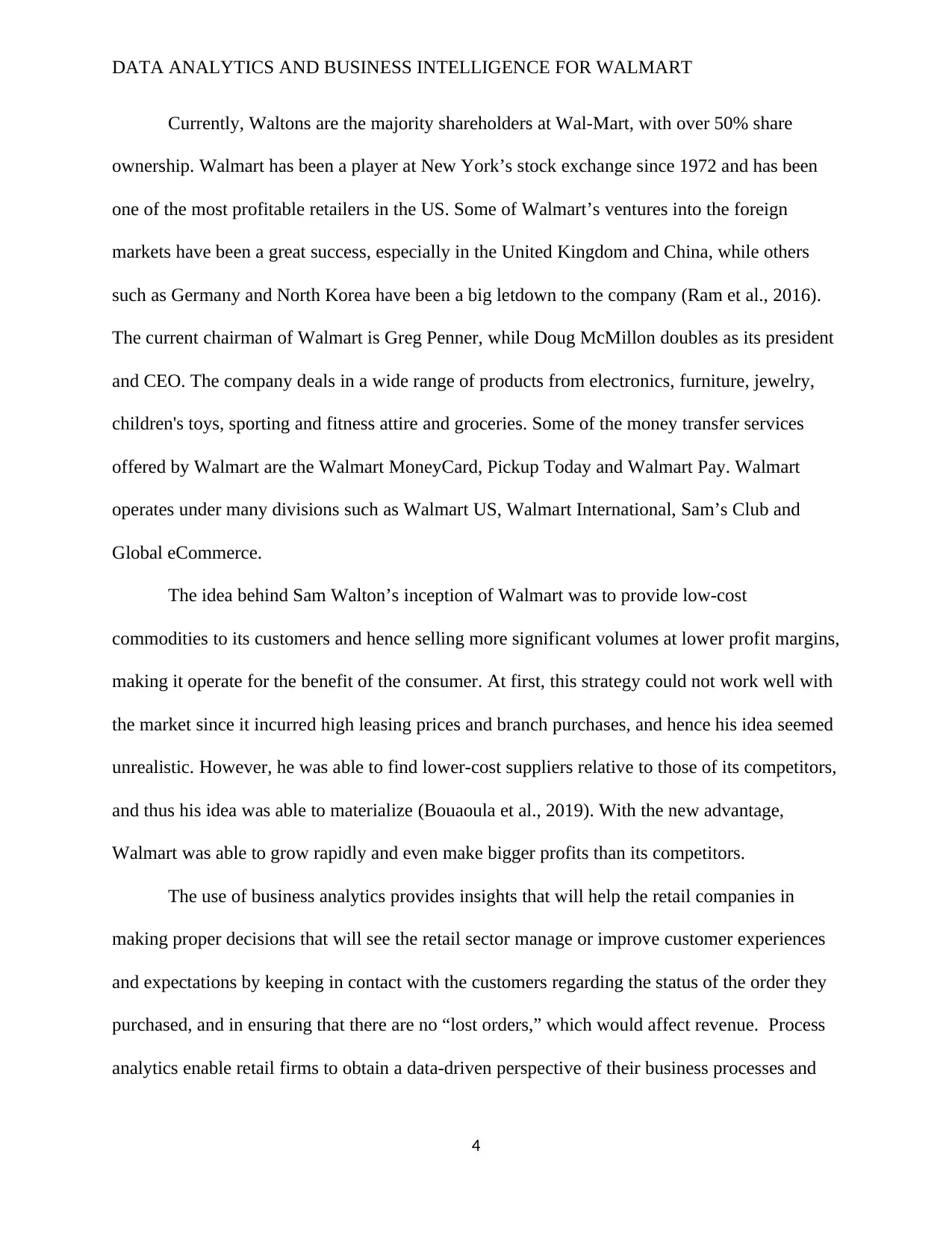
DATA ANALYTICS AND BUSINESS INTELLIGENCE FOR WALMART
Currently, Waltons are the majority shareholders at Wal-Mart, with over 50% share
ownership. Walmart has been a player at New York’s stock exchange since 1972 and has been
one of the most profitable retailers in the US. Some of Walmart’s ventures into the foreign
markets have been a great success, especially in the United Kingdom and China, while others
such as Germany and North Korea have been a big letdown to the company (Ram et al., 2016).
The current chairman of Walmart is Greg Penner, while Doug McMillon doubles as its president
and CEO. The company deals in a wide range of products from electronics, furniture, jewelry,
children's toys, sporting and fitness attire and groceries. Some of the money transfer services
offered by Walmart are the Walmart MoneyCard, Pickup Today and Walmart Pay. Walmart
operates under many divisions such as Walmart US, Walmart International, Sam’s Club and
Global eCommerce.
The idea behind Sam Walton’s inception of Walmart was to provide low-cost
commodities to its customers and hence selling more significant volumes at lower profit margins,
making it operate for the benefit of the consumer. At first, this strategy could not work well with
the market since it incurred high leasing prices and branch purchases, and hence his idea seemed
unrealistic. However, he was able to find lower-cost suppliers relative to those of its competitors,
and thus his idea was able to materialize (Bouaoula et al., 2019). With the new advantage,
Walmart was able to grow rapidly and even make bigger profits than its competitors.
The use of business analytics provides insights that will help the retail companies in
making proper decisions that will see the retail sector manage or improve customer experiences
and expectations by keeping in contact with the customers regarding the status of the order they
purchased, and in ensuring that there are no “lost orders,” which would affect revenue. Process
analytics enable retail firms to obtain a data-driven perspective of their business processes and
4
Currently, Waltons are the majority shareholders at Wal-Mart, with over 50% share
ownership. Walmart has been a player at New York’s stock exchange since 1972 and has been
one of the most profitable retailers in the US. Some of Walmart’s ventures into the foreign
markets have been a great success, especially in the United Kingdom and China, while others
such as Germany and North Korea have been a big letdown to the company (Ram et al., 2016).
The current chairman of Walmart is Greg Penner, while Doug McMillon doubles as its president
and CEO. The company deals in a wide range of products from electronics, furniture, jewelry,
children's toys, sporting and fitness attire and groceries. Some of the money transfer services
offered by Walmart are the Walmart MoneyCard, Pickup Today and Walmart Pay. Walmart
operates under many divisions such as Walmart US, Walmart International, Sam’s Club and
Global eCommerce.
The idea behind Sam Walton’s inception of Walmart was to provide low-cost
commodities to its customers and hence selling more significant volumes at lower profit margins,
making it operate for the benefit of the consumer. At first, this strategy could not work well with
the market since it incurred high leasing prices and branch purchases, and hence his idea seemed
unrealistic. However, he was able to find lower-cost suppliers relative to those of its competitors,
and thus his idea was able to materialize (Bouaoula et al., 2019). With the new advantage,
Walmart was able to grow rapidly and even make bigger profits than its competitors.
The use of business analytics provides insights that will help the retail companies in
making proper decisions that will see the retail sector manage or improve customer experiences
and expectations by keeping in contact with the customers regarding the status of the order they
purchased, and in ensuring that there are no “lost orders,” which would affect revenue. Process
analytics enable retail firms to obtain a data-driven perspective of their business processes and
4
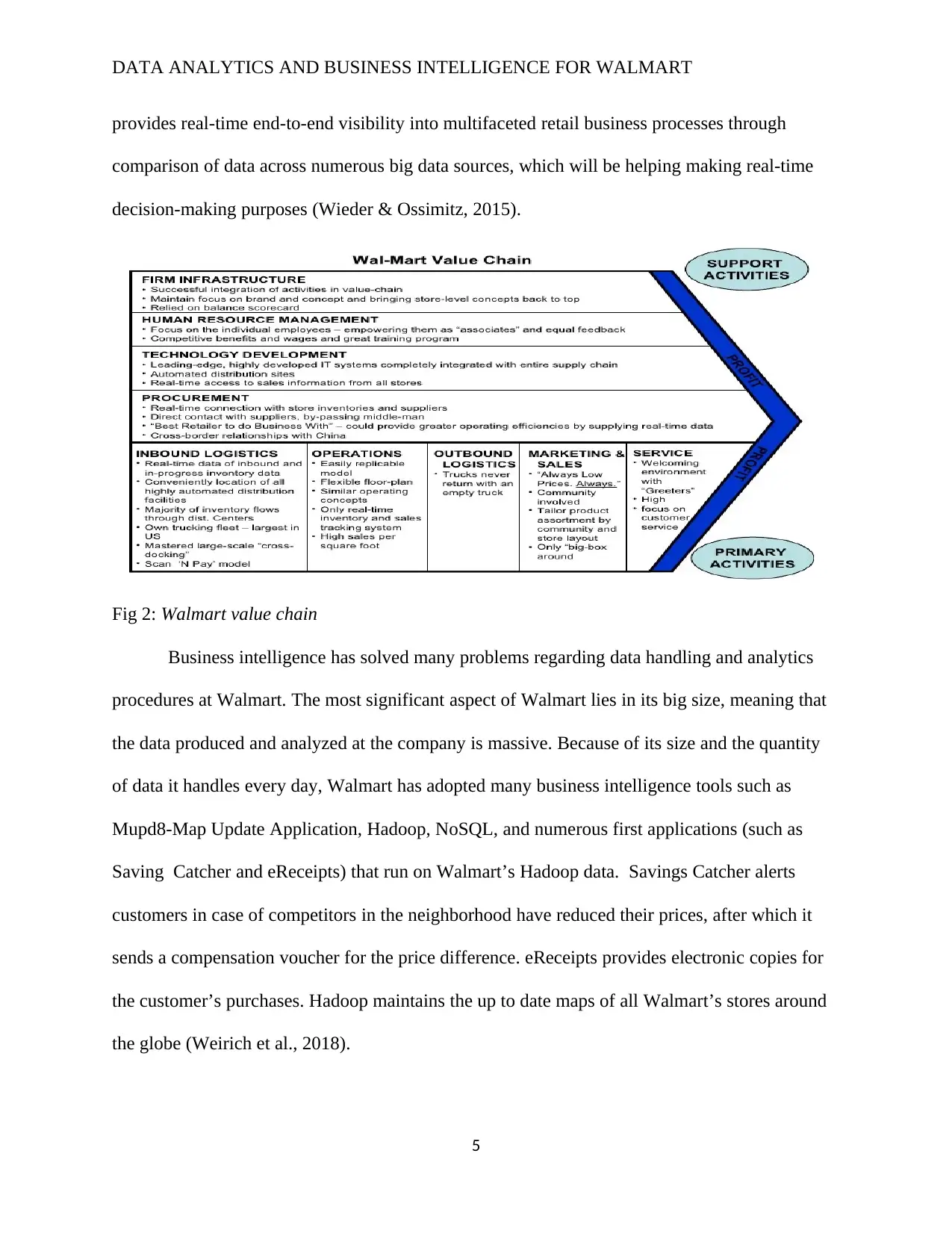
DATA ANALYTICS AND BUSINESS INTELLIGENCE FOR WALMART
provides real-time end-to-end visibility into multifaceted retail business processes through
comparison of data across numerous big data sources, which will be helping making real-time
decision-making purposes (Wieder & Ossimitz, 2015).
Fig 2: Walmart value chain
Business intelligence has solved many problems regarding data handling and analytics
procedures at Walmart. The most significant aspect of Walmart lies in its big size, meaning that
the data produced and analyzed at the company is massive. Because of its size and the quantity
of data it handles every day, Walmart has adopted many business intelligence tools such as
Mupd8-Map Update Application, Hadoop, NoSQL, and numerous first applications (such as
Saving Catcher and eReceipts) that run on Walmart’s Hadoop data. Savings Catcher alerts
customers in case of competitors in the neighborhood have reduced their prices, after which it
sends a compensation voucher for the price difference. eReceipts provides electronic copies for
the customer’s purchases. Hadoop maintains the up to date maps of all Walmart’s stores around
the globe (Weirich et al., 2018).
5
provides real-time end-to-end visibility into multifaceted retail business processes through
comparison of data across numerous big data sources, which will be helping making real-time
decision-making purposes (Wieder & Ossimitz, 2015).
Fig 2: Walmart value chain
Business intelligence has solved many problems regarding data handling and analytics
procedures at Walmart. The most significant aspect of Walmart lies in its big size, meaning that
the data produced and analyzed at the company is massive. Because of its size and the quantity
of data it handles every day, Walmart has adopted many business intelligence tools such as
Mupd8-Map Update Application, Hadoop, NoSQL, and numerous first applications (such as
Saving Catcher and eReceipts) that run on Walmart’s Hadoop data. Savings Catcher alerts
customers in case of competitors in the neighborhood have reduced their prices, after which it
sends a compensation voucher for the price difference. eReceipts provides electronic copies for
the customer’s purchases. Hadoop maintains the up to date maps of all Walmart’s stores around
the globe (Weirich et al., 2018).
5
⊘ This is a preview!⊘
Do you want full access?
Subscribe today to unlock all pages.

Trusted by 1+ million students worldwide
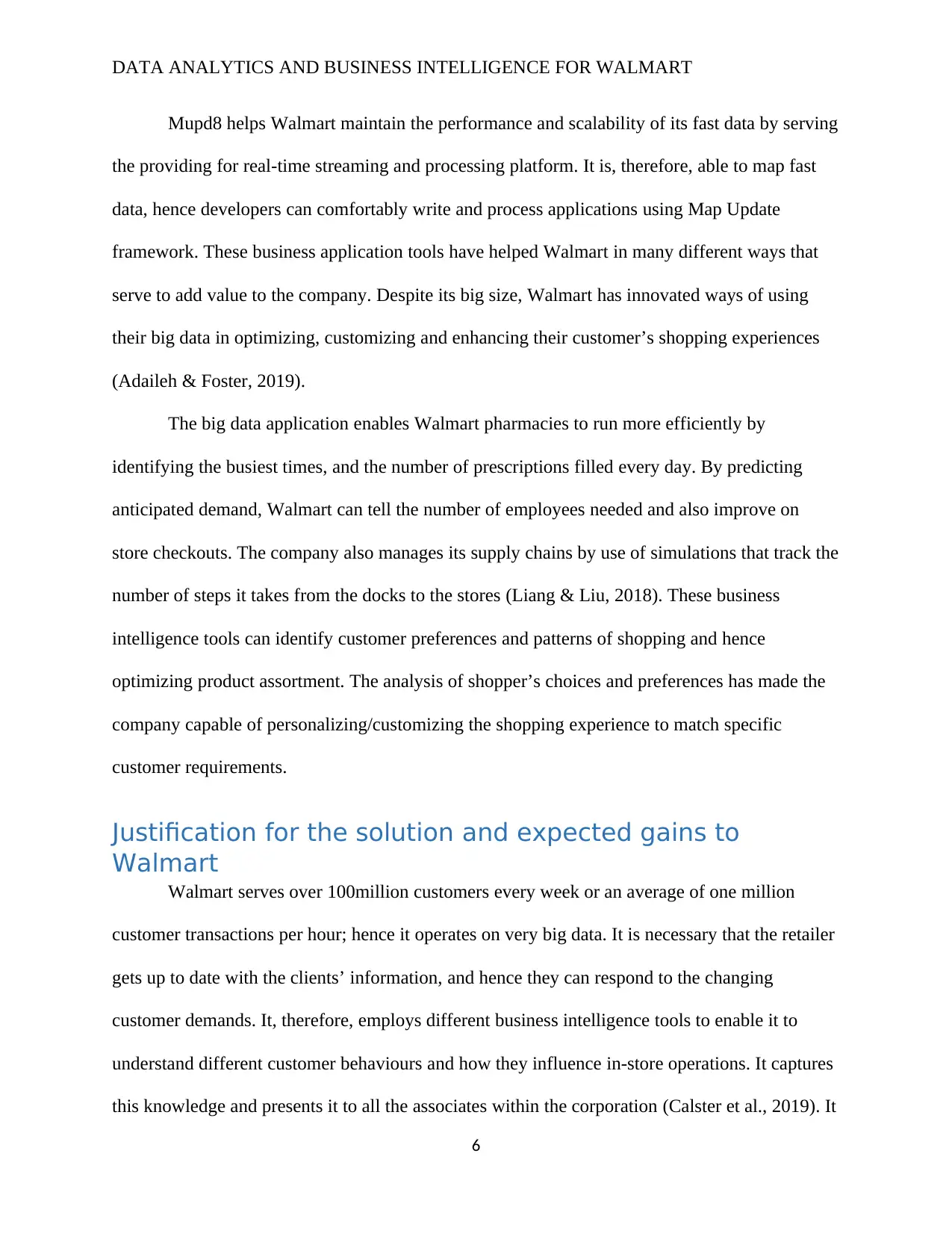
DATA ANALYTICS AND BUSINESS INTELLIGENCE FOR WALMART
Mupd8 helps Walmart maintain the performance and scalability of its fast data by serving
the providing for real-time streaming and processing platform. It is, therefore, able to map fast
data, hence developers can comfortably write and process applications using Map Update
framework. These business application tools have helped Walmart in many different ways that
serve to add value to the company. Despite its big size, Walmart has innovated ways of using
their big data in optimizing, customizing and enhancing their customer’s shopping experiences
(Adaileh & Foster, 2019).
The big data application enables Walmart pharmacies to run more efficiently by
identifying the busiest times, and the number of prescriptions filled every day. By predicting
anticipated demand, Walmart can tell the number of employees needed and also improve on
store checkouts. The company also manages its supply chains by use of simulations that track the
number of steps it takes from the docks to the stores (Liang & Liu, 2018). These business
intelligence tools can identify customer preferences and patterns of shopping and hence
optimizing product assortment. The analysis of shopper’s choices and preferences has made the
company capable of personalizing/customizing the shopping experience to match specific
customer requirements.
Justification for the solution and expected gains to
Walmart
Walmart serves over 100million customers every week or an average of one million
customer transactions per hour; hence it operates on very big data. It is necessary that the retailer
gets up to date with the clients’ information, and hence they can respond to the changing
customer demands. It, therefore, employs different business intelligence tools to enable it to
understand different customer behaviours and how they influence in-store operations. It captures
this knowledge and presents it to all the associates within the corporation (Calster et al., 2019). It
6
Mupd8 helps Walmart maintain the performance and scalability of its fast data by serving
the providing for real-time streaming and processing platform. It is, therefore, able to map fast
data, hence developers can comfortably write and process applications using Map Update
framework. These business application tools have helped Walmart in many different ways that
serve to add value to the company. Despite its big size, Walmart has innovated ways of using
their big data in optimizing, customizing and enhancing their customer’s shopping experiences
(Adaileh & Foster, 2019).
The big data application enables Walmart pharmacies to run more efficiently by
identifying the busiest times, and the number of prescriptions filled every day. By predicting
anticipated demand, Walmart can tell the number of employees needed and also improve on
store checkouts. The company also manages its supply chains by use of simulations that track the
number of steps it takes from the docks to the stores (Liang & Liu, 2018). These business
intelligence tools can identify customer preferences and patterns of shopping and hence
optimizing product assortment. The analysis of shopper’s choices and preferences has made the
company capable of personalizing/customizing the shopping experience to match specific
customer requirements.
Justification for the solution and expected gains to
Walmart
Walmart serves over 100million customers every week or an average of one million
customer transactions per hour; hence it operates on very big data. It is necessary that the retailer
gets up to date with the clients’ information, and hence they can respond to the changing
customer demands. It, therefore, employs different business intelligence tools to enable it to
understand different customer behaviours and how they influence in-store operations. It captures
this knowledge and presents it to all the associates within the corporation (Calster et al., 2019). It
6
Paraphrase This Document
Need a fresh take? Get an instant paraphrase of this document with our AI Paraphraser

DATA ANALYTICS AND BUSINESS INTELLIGENCE FOR WALMART
is challenging to handle such big data especially being that the company aims to grow and
improve its Human Resource team, hence calls for a great demand for a highly skilled team of
analysts.
The adoption of BI in the retail sector will make it easier for customers to find
information about products (both online/in-store) they want to buy or get help when planning to
purchase the products. The use of autonomous BI systems in the retail sector will generally
automate business operations in the retail sector, improve efficiency as well as enhance
consumer satisfaction. The application of Business Intelligence in the retail sector for making
strategic and tactical decisions will enhance efficiency, productivity, and streamline operations,
which will ultimately have an important impact on retail business growth leading to higher profit
margins (Batistič & Laken, 2019).
The use of different tools of business intelligence has made it easy whereby Walmart has
managed to use this big data to the benefit of itself and to foster its growth. It has also developed
its software that can collect customer’s information and analyze the data and make decisions
dependent on them. It has also managed to consolidate over ten different websites into one big
web and therefore store all the data on its new giant website. By applying business intelligence
tools, Walmart has been able to maintain constant updates of the information its customers leave
behind and hence they have been able to keep up with the changing customer demands (Zhang &
Zhou, 2019). They also have over six hundred pop up stores and even a Teradata based master
data management.
Walmart’s business intelligence tools can gather such a large quantity of data and provide
the company with intelligence that would determine customer patterns, trends, and insights. By
knowing specific customers, the company can provide customized service to its customers, and
7
is challenging to handle such big data especially being that the company aims to grow and
improve its Human Resource team, hence calls for a great demand for a highly skilled team of
analysts.
The adoption of BI in the retail sector will make it easier for customers to find
information about products (both online/in-store) they want to buy or get help when planning to
purchase the products. The use of autonomous BI systems in the retail sector will generally
automate business operations in the retail sector, improve efficiency as well as enhance
consumer satisfaction. The application of Business Intelligence in the retail sector for making
strategic and tactical decisions will enhance efficiency, productivity, and streamline operations,
which will ultimately have an important impact on retail business growth leading to higher profit
margins (Batistič & Laken, 2019).
The use of different tools of business intelligence has made it easy whereby Walmart has
managed to use this big data to the benefit of itself and to foster its growth. It has also developed
its software that can collect customer’s information and analyze the data and make decisions
dependent on them. It has also managed to consolidate over ten different websites into one big
web and therefore store all the data on its new giant website. By applying business intelligence
tools, Walmart has been able to maintain constant updates of the information its customers leave
behind and hence they have been able to keep up with the changing customer demands (Zhang &
Zhou, 2019). They also have over six hundred pop up stores and even a Teradata based master
data management.
Walmart’s business intelligence tools can gather such a large quantity of data and provide
the company with intelligence that would determine customer patterns, trends, and insights. By
knowing specific customers, the company can provide customized service to its customers, and
7

DATA ANALYTICS AND BUSINESS INTELLIGENCE FOR WALMART
hence it can attract its customers by its side and also maintain them, hence adding essential value
to the company (Elbashir et al., 2013).
For instance, before introducing business intelligence, Walmart’s managers were not able
to connect with its customers positively, and hence this led to a decline in its business operations.
Introduction of SAS Analytics business intelligence helped Walmart gave it the ability to analyze
and monitor consumer patterns and behaviours for large data sets. Apart from Walmart,
Hallmark has also adopted this kind of business intelligence, and the results have been amazing
(Richards et al., 2019).
SAS Analytics has continuously added value to the hospital in many ways. It has enabled
Walmart to understand the customer and consumer behavioural changes and hence giving the
company a competitive advantage. Walmart is, therefore, able to understand its customers and
hence they make more effective sales to them. It also provides additional control for different
management levels, and thus they can show their way of dealing with customers appropriately
(Chen et al., 2012).
Retail companies can apply or use Big data analytics to examine big data (varied and big
data sets) to reveal data such as hidden trends or patterns, determine relationships, identify
consumer preferences and market trends, which will be useful in decision making, for example,
making informed and smarter business decisions (Islam et al., 2018). Retail firms can also use
big data analytics for detecting fraud and in obtaining extra business understanding. Using big
data analytics technologies, companies can tap value from big data from different sources,
including data mining, and analyze the data to provide analytic insights that will be useful in
making better operational, tactical or strategic decisions. Fig. 3 shows the use of big data
analytics to make decisions in retails firms (Shankar, 2019).
8
hence it can attract its customers by its side and also maintain them, hence adding essential value
to the company (Elbashir et al., 2013).
For instance, before introducing business intelligence, Walmart’s managers were not able
to connect with its customers positively, and hence this led to a decline in its business operations.
Introduction of SAS Analytics business intelligence helped Walmart gave it the ability to analyze
and monitor consumer patterns and behaviours for large data sets. Apart from Walmart,
Hallmark has also adopted this kind of business intelligence, and the results have been amazing
(Richards et al., 2019).
SAS Analytics has continuously added value to the hospital in many ways. It has enabled
Walmart to understand the customer and consumer behavioural changes and hence giving the
company a competitive advantage. Walmart is, therefore, able to understand its customers and
hence they make more effective sales to them. It also provides additional control for different
management levels, and thus they can show their way of dealing with customers appropriately
(Chen et al., 2012).
Retail companies can apply or use Big data analytics to examine big data (varied and big
data sets) to reveal data such as hidden trends or patterns, determine relationships, identify
consumer preferences and market trends, which will be useful in decision making, for example,
making informed and smarter business decisions (Islam et al., 2018). Retail firms can also use
big data analytics for detecting fraud and in obtaining extra business understanding. Using big
data analytics technologies, companies can tap value from big data from different sources,
including data mining, and analyze the data to provide analytic insights that will be useful in
making better operational, tactical or strategic decisions. Fig. 3 shows the use of big data
analytics to make decisions in retails firms (Shankar, 2019).
8
⊘ This is a preview!⊘
Do you want full access?
Subscribe today to unlock all pages.

Trusted by 1+ million students worldwide
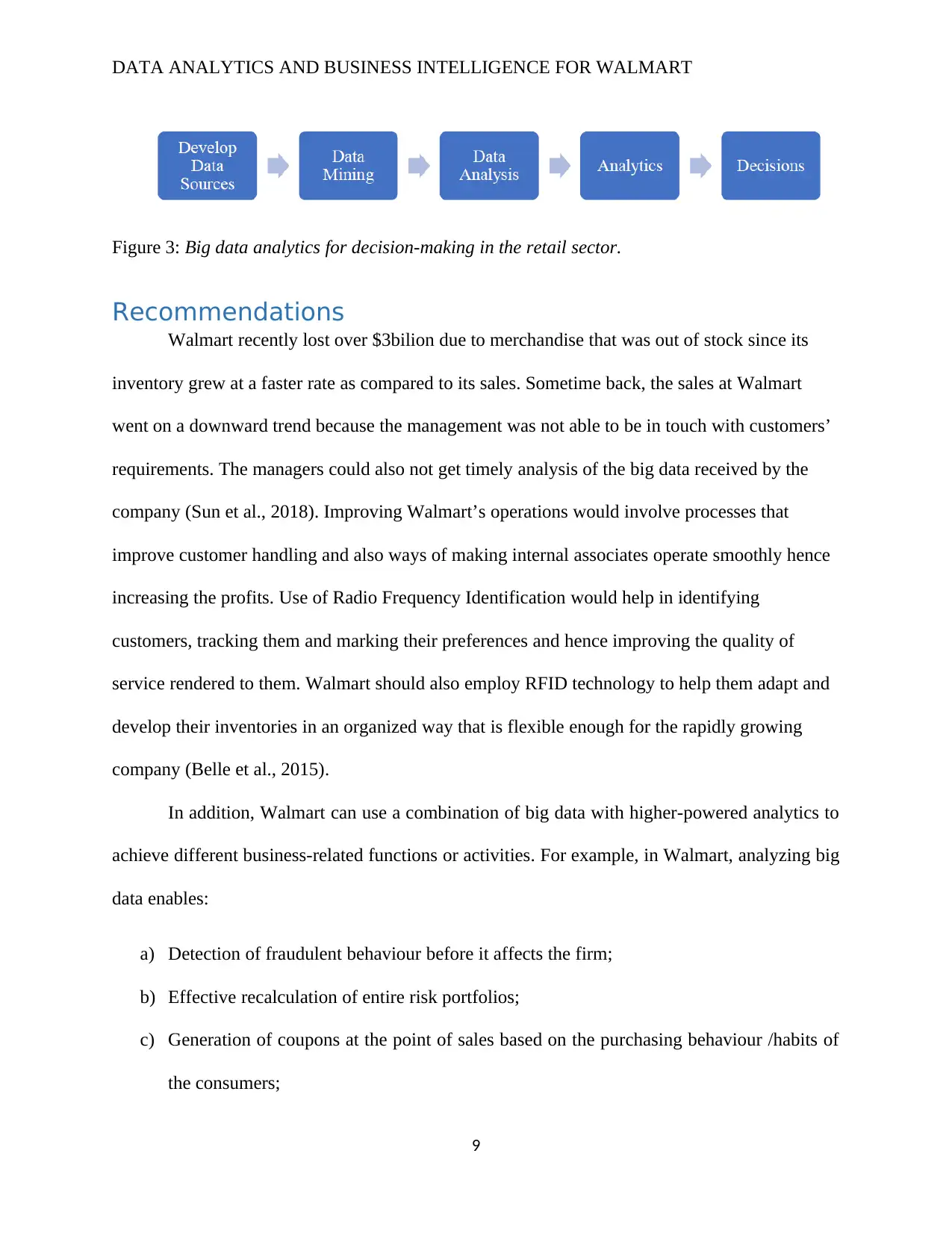
DATA ANALYTICS AND BUSINESS INTELLIGENCE FOR WALMART
Figure 3: Big data analytics for decision-making in the retail sector.
Recommendations
Walmart recently lost over $3bilion due to merchandise that was out of stock since its
inventory grew at a faster rate as compared to its sales. Sometime back, the sales at Walmart
went on a downward trend because the management was not able to be in touch with customers’
requirements. The managers could also not get timely analysis of the big data received by the
company (Sun et al., 2018). Improving Walmart’s operations would involve processes that
improve customer handling and also ways of making internal associates operate smoothly hence
increasing the profits. Use of Radio Frequency Identification would help in identifying
customers, tracking them and marking their preferences and hence improving the quality of
service rendered to them. Walmart should also employ RFID technology to help them adapt and
develop their inventories in an organized way that is flexible enough for the rapidly growing
company (Belle et al., 2015).
In addition, Walmart can use a combination of big data with higher-powered analytics to
achieve different business-related functions or activities. For example, in Walmart, analyzing big
data enables:
a) Detection of fraudulent behaviour before it affects the firm;
b) Effective recalculation of entire risk portfolios;
c) Generation of coupons at the point of sales based on the purchasing behaviour /habits of
the consumers;
9
Figure 3: Big data analytics for decision-making in the retail sector.
Recommendations
Walmart recently lost over $3bilion due to merchandise that was out of stock since its
inventory grew at a faster rate as compared to its sales. Sometime back, the sales at Walmart
went on a downward trend because the management was not able to be in touch with customers’
requirements. The managers could also not get timely analysis of the big data received by the
company (Sun et al., 2018). Improving Walmart’s operations would involve processes that
improve customer handling and also ways of making internal associates operate smoothly hence
increasing the profits. Use of Radio Frequency Identification would help in identifying
customers, tracking them and marking their preferences and hence improving the quality of
service rendered to them. Walmart should also employ RFID technology to help them adapt and
develop their inventories in an organized way that is flexible enough for the rapidly growing
company (Belle et al., 2015).
In addition, Walmart can use a combination of big data with higher-powered analytics to
achieve different business-related functions or activities. For example, in Walmart, analyzing big
data enables:
a) Detection of fraudulent behaviour before it affects the firm;
b) Effective recalculation of entire risk portfolios;
c) Generation of coupons at the point of sales based on the purchasing behaviour /habits of
the consumers;
9
Paraphrase This Document
Need a fresh take? Get an instant paraphrase of this document with our AI Paraphraser
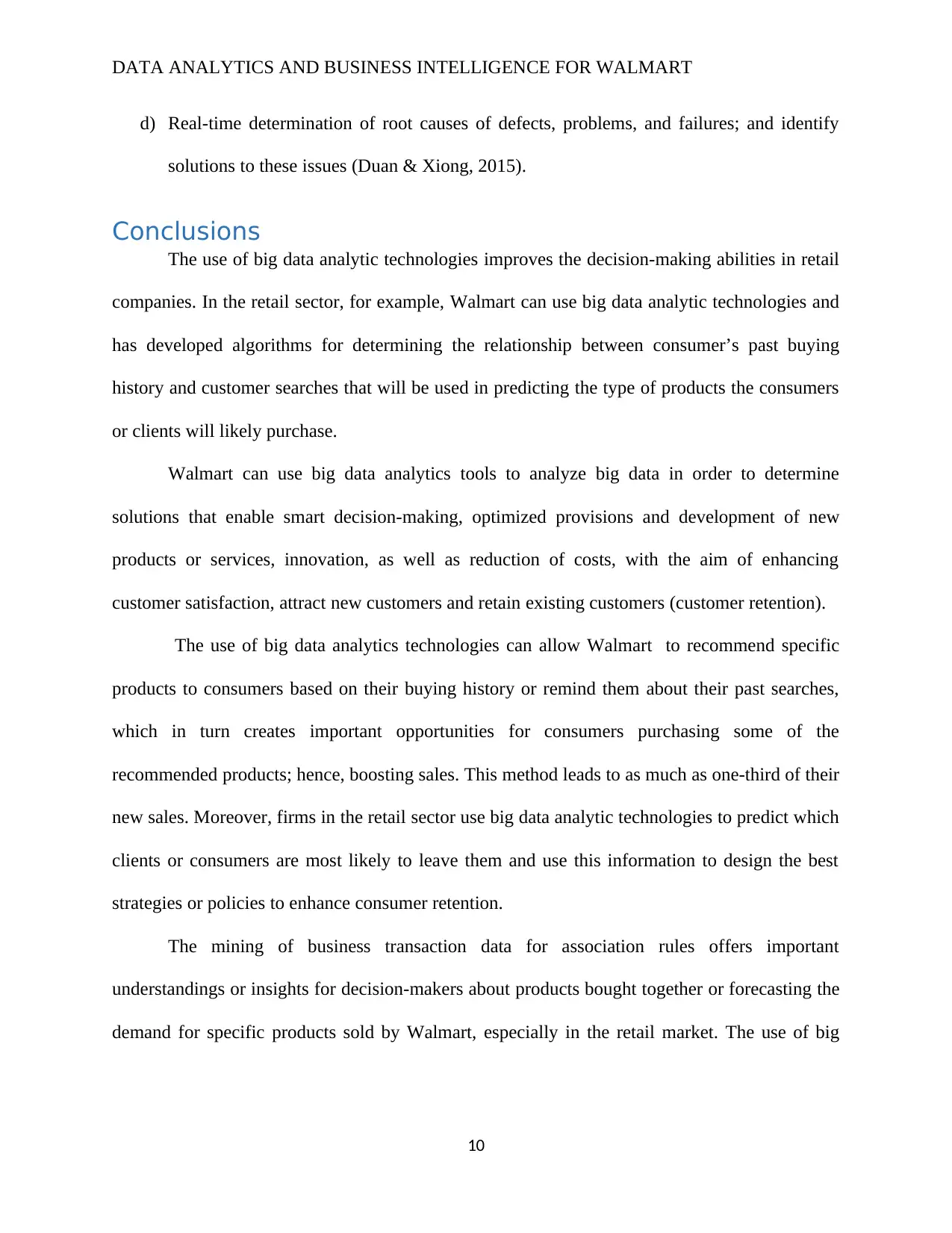
DATA ANALYTICS AND BUSINESS INTELLIGENCE FOR WALMART
d) Real-time determination of root causes of defects, problems, and failures; and identify
solutions to these issues (Duan & Xiong, 2015).
Conclusions
The use of big data analytic technologies improves the decision-making abilities in retail
companies. In the retail sector, for example, Walmart can use big data analytic technologies and
has developed algorithms for determining the relationship between consumer’s past buying
history and customer searches that will be used in predicting the type of products the consumers
or clients will likely purchase.
Walmart can use big data analytics tools to analyze big data in order to determine
solutions that enable smart decision-making, optimized provisions and development of new
products or services, innovation, as well as reduction of costs, with the aim of enhancing
customer satisfaction, attract new customers and retain existing customers (customer retention).
The use of big data analytics technologies can allow Walmart to recommend specific
products to consumers based on their buying history or remind them about their past searches,
which in turn creates important opportunities for consumers purchasing some of the
recommended products; hence, boosting sales. This method leads to as much as one-third of their
new sales. Moreover, firms in the retail sector use big data analytic technologies to predict which
clients or consumers are most likely to leave them and use this information to design the best
strategies or policies to enhance consumer retention.
The mining of business transaction data for association rules offers important
understandings or insights for decision-makers about products bought together or forecasting the
demand for specific products sold by Walmart, especially in the retail market. The use of big
10
d) Real-time determination of root causes of defects, problems, and failures; and identify
solutions to these issues (Duan & Xiong, 2015).
Conclusions
The use of big data analytic technologies improves the decision-making abilities in retail
companies. In the retail sector, for example, Walmart can use big data analytic technologies and
has developed algorithms for determining the relationship between consumer’s past buying
history and customer searches that will be used in predicting the type of products the consumers
or clients will likely purchase.
Walmart can use big data analytics tools to analyze big data in order to determine
solutions that enable smart decision-making, optimized provisions and development of new
products or services, innovation, as well as reduction of costs, with the aim of enhancing
customer satisfaction, attract new customers and retain existing customers (customer retention).
The use of big data analytics technologies can allow Walmart to recommend specific
products to consumers based on their buying history or remind them about their past searches,
which in turn creates important opportunities for consumers purchasing some of the
recommended products; hence, boosting sales. This method leads to as much as one-third of their
new sales. Moreover, firms in the retail sector use big data analytic technologies to predict which
clients or consumers are most likely to leave them and use this information to design the best
strategies or policies to enhance consumer retention.
The mining of business transaction data for association rules offers important
understandings or insights for decision-makers about products bought together or forecasting the
demand for specific products sold by Walmart, especially in the retail market. The use of big
10
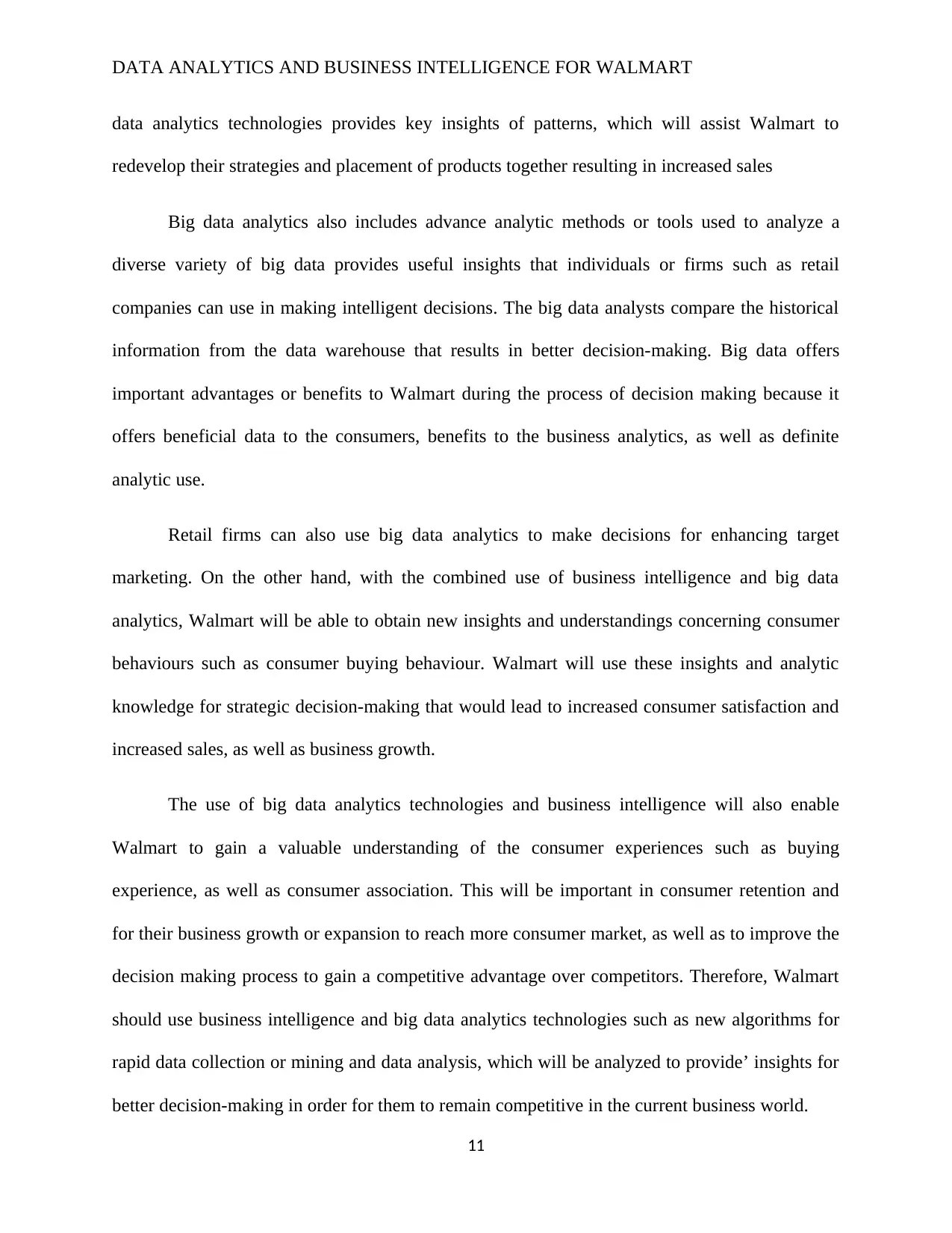
DATA ANALYTICS AND BUSINESS INTELLIGENCE FOR WALMART
data analytics technologies provides key insights of patterns, which will assist Walmart to
redevelop their strategies and placement of products together resulting in increased sales
Big data analytics also includes advance analytic methods or tools used to analyze a
diverse variety of big data provides useful insights that individuals or firms such as retail
companies can use in making intelligent decisions. The big data analysts compare the historical
information from the data warehouse that results in better decision-making. Big data offers
important advantages or benefits to Walmart during the process of decision making because it
offers beneficial data to the consumers, benefits to the business analytics, as well as definite
analytic use.
Retail firms can also use big data analytics to make decisions for enhancing target
marketing. On the other hand, with the combined use of business intelligence and big data
analytics, Walmart will be able to obtain new insights and understandings concerning consumer
behaviours such as consumer buying behaviour. Walmart will use these insights and analytic
knowledge for strategic decision-making that would lead to increased consumer satisfaction and
increased sales, as well as business growth.
The use of big data analytics technologies and business intelligence will also enable
Walmart to gain a valuable understanding of the consumer experiences such as buying
experience, as well as consumer association. This will be important in consumer retention and
for their business growth or expansion to reach more consumer market, as well as to improve the
decision making process to gain a competitive advantage over competitors. Therefore, Walmart
should use business intelligence and big data analytics technologies such as new algorithms for
rapid data collection or mining and data analysis, which will be analyzed to provide’ insights for
better decision-making in order for them to remain competitive in the current business world.
11
data analytics technologies provides key insights of patterns, which will assist Walmart to
redevelop their strategies and placement of products together resulting in increased sales
Big data analytics also includes advance analytic methods or tools used to analyze a
diverse variety of big data provides useful insights that individuals or firms such as retail
companies can use in making intelligent decisions. The big data analysts compare the historical
information from the data warehouse that results in better decision-making. Big data offers
important advantages or benefits to Walmart during the process of decision making because it
offers beneficial data to the consumers, benefits to the business analytics, as well as definite
analytic use.
Retail firms can also use big data analytics to make decisions for enhancing target
marketing. On the other hand, with the combined use of business intelligence and big data
analytics, Walmart will be able to obtain new insights and understandings concerning consumer
behaviours such as consumer buying behaviour. Walmart will use these insights and analytic
knowledge for strategic decision-making that would lead to increased consumer satisfaction and
increased sales, as well as business growth.
The use of big data analytics technologies and business intelligence will also enable
Walmart to gain a valuable understanding of the consumer experiences such as buying
experience, as well as consumer association. This will be important in consumer retention and
for their business growth or expansion to reach more consumer market, as well as to improve the
decision making process to gain a competitive advantage over competitors. Therefore, Walmart
should use business intelligence and big data analytics technologies such as new algorithms for
rapid data collection or mining and data analysis, which will be analyzed to provide’ insights for
better decision-making in order for them to remain competitive in the current business world.
11
⊘ This is a preview!⊘
Do you want full access?
Subscribe today to unlock all pages.

Trusted by 1+ million students worldwide
1 out of 15
Related Documents
Your All-in-One AI-Powered Toolkit for Academic Success.
+13062052269
info@desklib.com
Available 24*7 on WhatsApp / Email
![[object Object]](/_next/static/media/star-bottom.7253800d.svg)
Unlock your academic potential
Copyright © 2020–2025 A2Z Services. All Rights Reserved. Developed and managed by ZUCOL.





